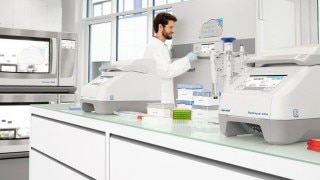MENÚ
AR | ARS
AR | ARS
Está a punto de abandonar este sitio.
Por favor, tenga en cuenta que su carro de la compra actual no ha sido guardado todavía y no podrá ser restablecido en el nuevo sitio ni cuando regrese. Si desea guardar su carro de la compra, inicie sesión en su cuenta.
myEppendorf
No se han encontrado resultados
Sugerencias de búsqueda

The Connected Lab – A Sunny Outlook for Cloud-Based Systems
Academia de laboratorio
- Soluciones digitales de laboratorio
- Ensayo
The lab has always been a truly interconnected place – not just because of the equipment and collaborations going on, but also because of the constantly evolving links between different scientific disciplines, views, and cultures. The role of cloud-based working in all of this: making connectivity easier and more reliable!
Whether it’s at home, on-the-go or at work – cloud-based system play an ever-increasing part in our daily lives. From the user’s perspective, the internet is quickly transforming from a means to send information into a place to store your information.
More and more specialized cloud monitoring in the lab are becoming available – aiming to offer bespoke solutions for different users and industries. Laboratories are no exception to this – and with good reasons. The close collaborations going on in the lab and the plethora of different instruments being used mean that there are real incentives to achieve a real connected lab.
Nevertheless, the switch to a cloud-based system can be a daunting one, and closely assessing the benefits to the lab in question is key to a successful switch. So where can the cloud make a real difference to the everyday lives of lab users?
With the right system, a cloud monitoring in the laboratory can make a real difference to lab efficiency. Improving connectivity and compatibility makes it easier to have all the right data in the right format at the right place. It ensures that staff or students can focus on the analysis rather than the logistics.
For example, in cell-based experiments cells and components for the cultivation are kept in freezers and incubators, where a perfect incubation atmosphere is required without any disruptions. The analysis may require spreadsheets for sample documentation, microscopy images, viability results from a plate reader, and PCR data. By organizing information directly in the cloud instead of on separate computers, researchers can monitor, organize, retrieve, and analyze their experiments faster and more easily.
Remote access to data and smart services is a key strength of cloud-based working. It means that more tasks can be done remotely, which can be in the office, at home or even when traveling. As a result, it’s easier for staff to schedule their work, which further improves efficiency.
When using a cloud-based system, it becomes easier to collaborate closely and effectively, as data from connected labs is available from any location. Experimental results, protocols, and images can be easily shared between collaborators instantly, which saves time and can improve the quality of experiments and processes.
The easy availability of data on the cloud fits well with this need for fast data and fast news as users can quickly share, check or analyze information as and when needed.
Nevertheless, it’s not impossible to combine accessibility with security. In fact, confidential data is already routinely transmitted over the internet via email and file-sharing applications. The key is to ensure security at every step: the cloud application itself, the devices it’s being used on, and the user. For this reason, it is important not just to invest in a secure system, but also to ensure that it’s used on secure, up-to-date hardware and that all users receive sufficient training.
Are you interested in learning more about cloud-based lab software solutions available from Eppendorf? Go and visit: www.eppendorf.com/digitallabsolutions
More and more specialized cloud monitoring in the lab are becoming available – aiming to offer bespoke solutions for different users and industries. Laboratories are no exception to this – and with good reasons. The close collaborations going on in the lab and the plethora of different instruments being used mean that there are real incentives to achieve a real connected lab.
Nevertheless, the switch to a cloud-based system can be a daunting one, and closely assessing the benefits to the lab in question is key to a successful switch. So where can the cloud make a real difference to the everyday lives of lab users?
Improving efficiency.
Efficiency will be the main driver for labs to move to a cloud-based approach. Lab work often generates data in various formats coming from a range of different instruments such as microscopes, plate readers, etc. As a result, many researchers spend a lot of time collecting, merging, transferring or reformatting data before the analysis can even begin.With the right system, a cloud monitoring in the laboratory can make a real difference to lab efficiency. Improving connectivity and compatibility makes it easier to have all the right data in the right format at the right place. It ensures that staff or students can focus on the analysis rather than the logistics.
For example, in cell-based experiments cells and components for the cultivation are kept in freezers and incubators, where a perfect incubation atmosphere is required without any disruptions. The analysis may require spreadsheets for sample documentation, microscopy images, viability results from a plate reader, and PCR data. By organizing information directly in the cloud instead of on separate computers, researchers can monitor, organize, retrieve, and analyze their experiments faster and more easily.
Data accessibility
Another important benefit for lab users is to have data accessible anywhere and to be able to access smart services such as cluoud monitoring or remote diagnostics for better service operations. Not only does this avoid many inconvenient and often unnecessary trips to the lab, it also enables users to respond quicker to unexpected situations.Remote access to data and smart services is a key strength of cloud-based working. It means that more tasks can be done remotely, which can be in the office, at home or even when traveling. As a result, it’s easier for staff to schedule their work, which further improves efficiency.
Facilitating collaboration
Collaboration between different researchers and labs is a cornerstone of modern lab work, both in academia and industry. In academia for example, it can help to advance research faster by, for example, bringing in different areas of expertise, and in industry it can ensure that operations run smoothly and efficiently, and that results are consistent between labs.When using a cloud-based system, it becomes easier to collaborate closely and effectively, as data from connected labs is available from any location. Experimental results, protocols, and images can be easily shared between collaborators instantly, which saves time and can improve the quality of experiments and processes.
Sharing knowledge
In modern science it’s becoming increasingly clear that it’s not just about gathering data and results; disseminating findings and conclusions as broadly as possible is just as important in order to gain recognition as well as directions for further research. And with the increasing speed at which information spreads, timing can be crucial.The easy availability of data on the cloud fits well with this need for fast data and fast news as users can quickly share, check or analyze information as and when needed.
But what about data security?
One key aspect that’s always at the top of people’s minds when considering cloud-based data storage is security – and for good reasons. Keeping data safe almost automatically becomes a growing challenge as the accessibility of the data increases.Nevertheless, it’s not impossible to combine accessibility with security. In fact, confidential data is already routinely transmitted over the internet via email and file-sharing applications. The key is to ensure security at every step: the cloud application itself, the devices it’s being used on, and the user. For this reason, it is important not just to invest in a secure system, but also to ensure that it’s used on secure, up-to-date hardware and that all users receive sufficient training.
Accessible. Connected. Innovative.
The cloud has brought, and is continuing to bring, substantial changes to the way we gather, use, and spread information. In many ways, the lab situation is unique in the way it encompasses a wide range of equipment and data sources. However, the complexity of lab data means that there is a huge potential for a cloud-based approach to make a significant impact – not just by saving time and improving efficiency, but also by making it easier to access, share, and innovate in a connected lab – wherever you are.Are you interested in learning more about cloud-based lab software solutions available from Eppendorf? Go and visit: www.eppendorf.com/digitallabsolutions
Leer más
Leer menos
Related links
Leer más
Leer menos

